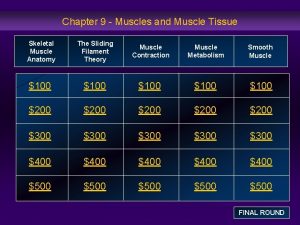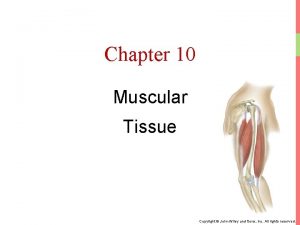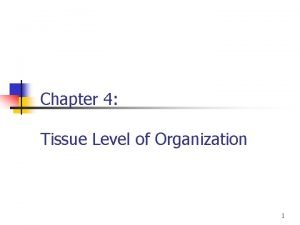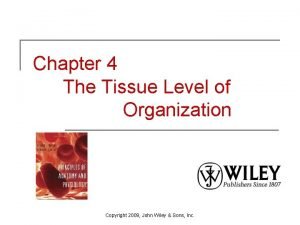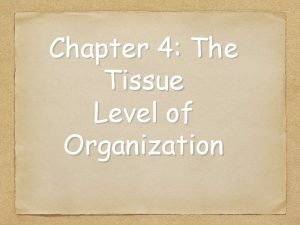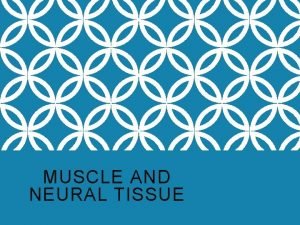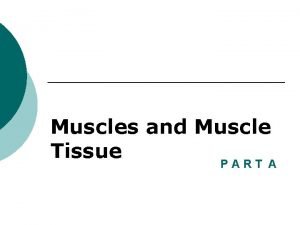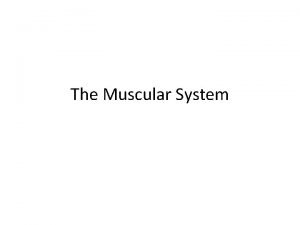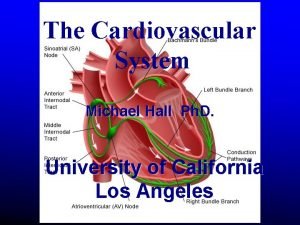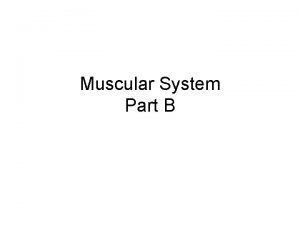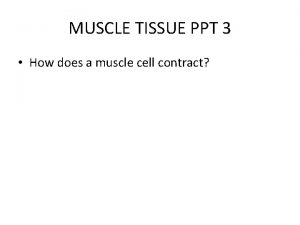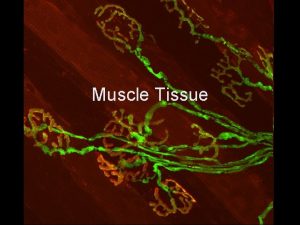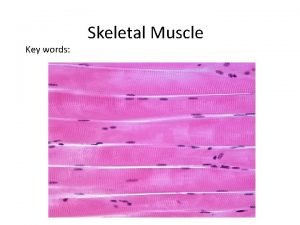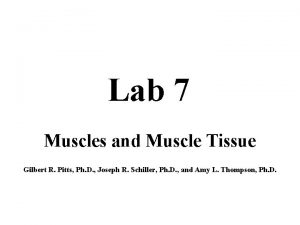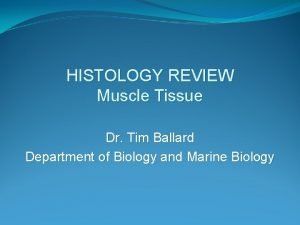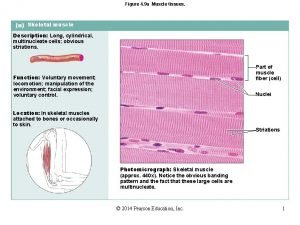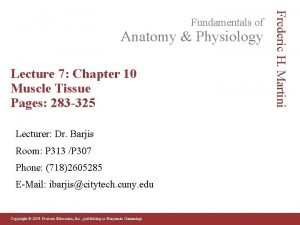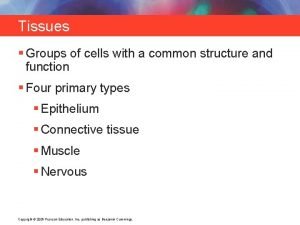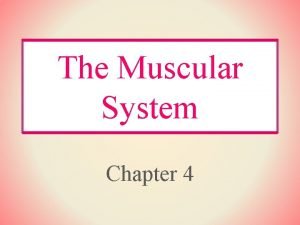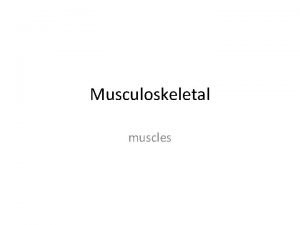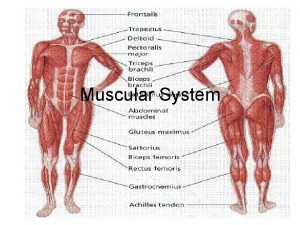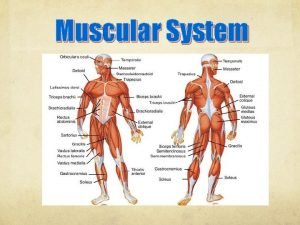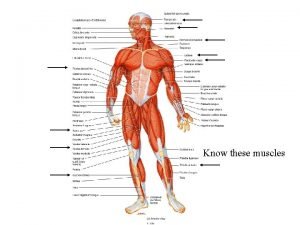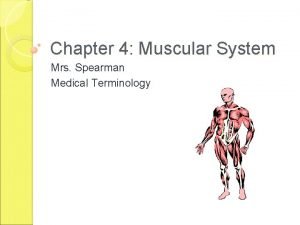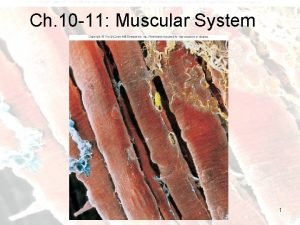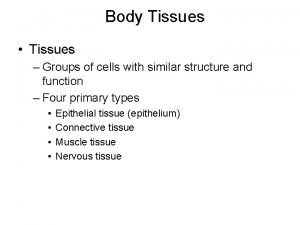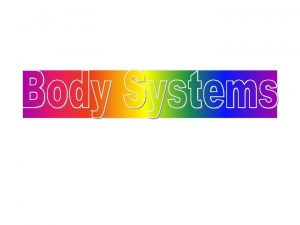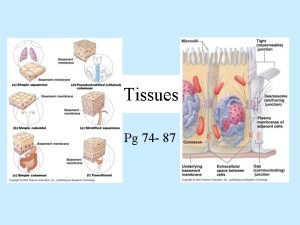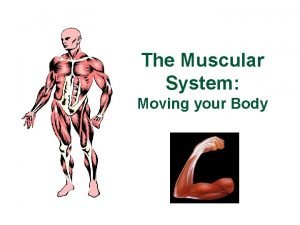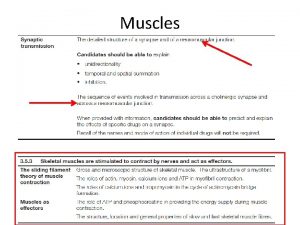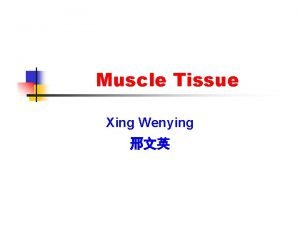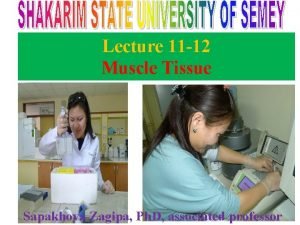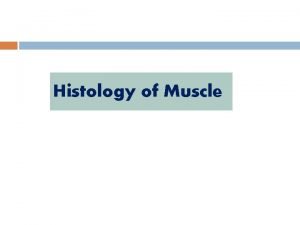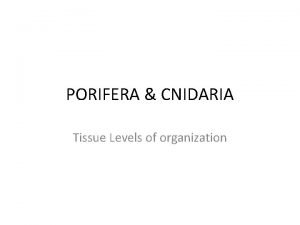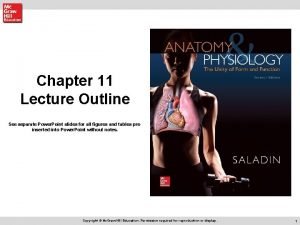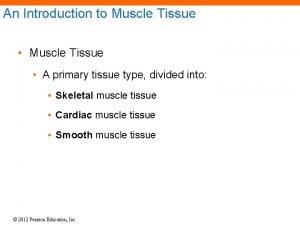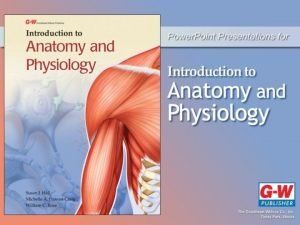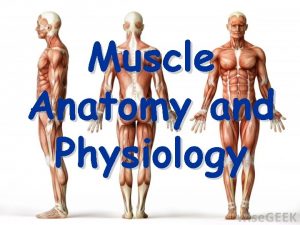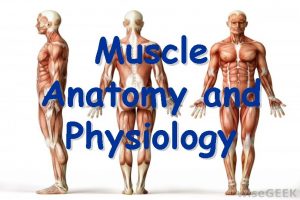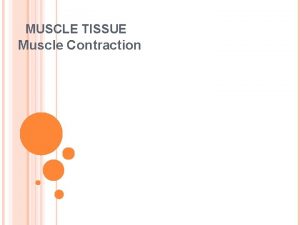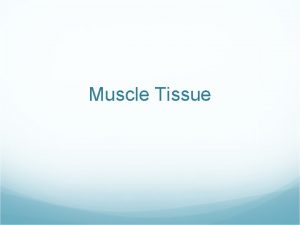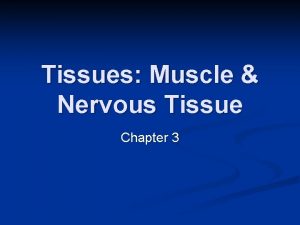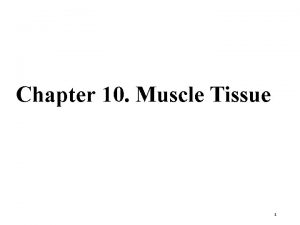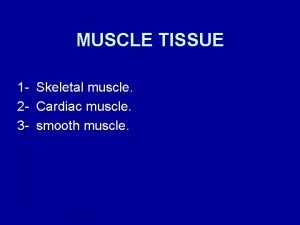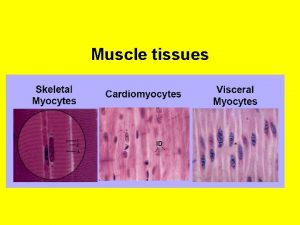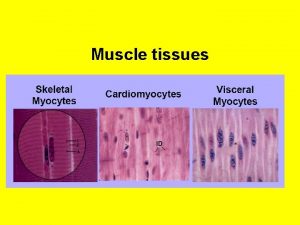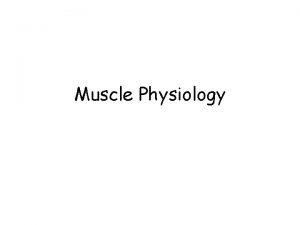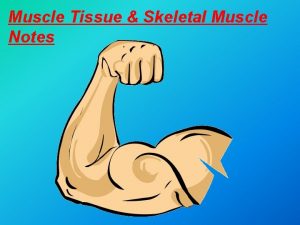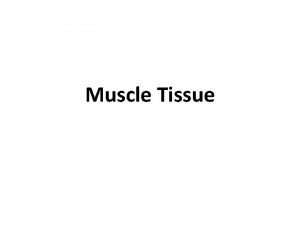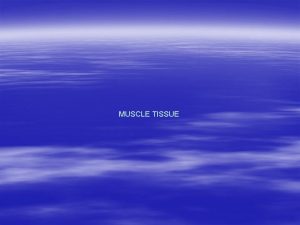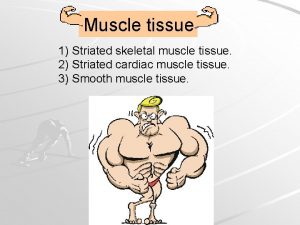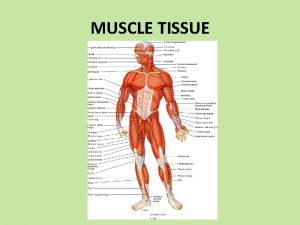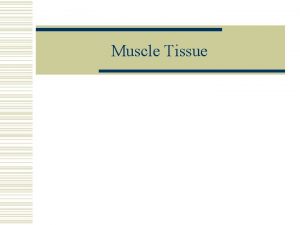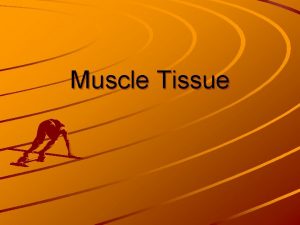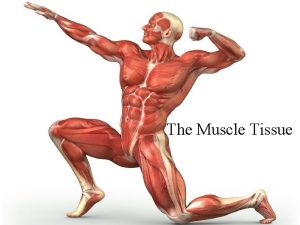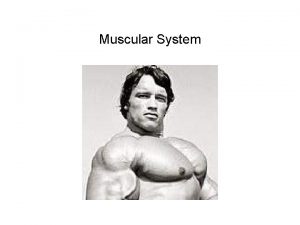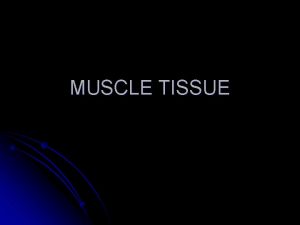CHAPTER 10 Muscle Tissue and Organization 1 2











































- Slides: 43

CHAPTER 10 “Muscle Tissue and Organization”

1. 2. 3. 4. 5. Objectives Describe and identify the 3 major muscle groups (skeletal, cardiac and, smooth). Describe the general anatomy of muscles. Describe the ultra-structure of skeletal muscle and its role in muscle contraction. Describe nerve-muscle relationship, the motor unit and the neuromuscular junction. Define the physiologic fiber types of muscle.

Functions of Muscle 1. Movement: skeletal, cardiac, and smooth muscles 2. Stability: skeletal muscle 3. Communication: skeletal muscle 4. Control of body openings and passages: skeletal and smooth muscles 5. Heat production: skeletal muscles

Properties of Muscles 1. Excitability (responsiveness) respond to chemical, mechanical or electrical stimuli. 2. Conductivity initiate events that lead to contraction. 3. Contractility ability to shorten substantially 4. Extensibility able to stretch between contractions. 5. Elasticity ability to return to original length after stretching.

Three muscle tissues 1. Skeletal muscle 2. Cardiac muscle 3. Smooth muscle

Skeletal Muscle • • Cells are long and cylindrical in shape Cells are multi-nucleated Cross-striations present Under voluntary control Contractile proteins: actin, myosin and tinin. Regulatory proteins: troponin and tropomyosin. Sarcomere is contractile unit of skeletal muscle; defined as the distance between 2 “Z” discs.


Prefixes referring to Skeletal Muscle Tissue • Myo- and Sarco • Myofibril, myofilament, endomysium, perimysium, epimysium • Sarcolemma, sarcoplasmic reticulum, sarcomere

Connective tissues and fascicles • Myofibril- composed of bundles of myofilaments • Endomysium- areolar CT covering each muscle fiber and binding it to its neighbors. • Perimysium- dense irregular CT covering muscle fascicles. • Fascicles- bundles of muscle fibers surrounded by perimysium. • Epimysium- covering of dense irregular CT surrounding the entire muscle.

Skeletal Muscle Whole muscle Single muscle fiber

Skeletal Muscle Structure/ Organization

Skeletal Muscle Fascicle Arrangements • fusiform – thick in the middle and taper at the ends • parallel – muscle fibers are all parallel • pennate –fascicles are short and attach obliquely to a central tendon (feather shaped) • convergent – spread out as a fan or converge to a point • circular – muscle fibers arranged concentrically

Parallel and Pennate

Circular and Convergent

Functional Groups of Muscles 1. prime mover or agonist –muscle whose contraction is responsible for a particular movement 2. synergists –muscles that assist the movement of the prime mover or agonist 3. antagonist –muscle whose action opposes that of the prime mover or agonist 4. fixators –stabilize the origin of the prime mover so it can move more efficiently. Origin - point of attachment where least movement occurs. Insertion – point of attachment with greatest movement.

Intrinsic and extrinsic muscles • Muscles are at times grouped as to the regions where they are found and function. • Intrinsic muscles are localized to a specific area (i. e. hand, tongue, back, etc. ). They function and are contained only within that area. • Extrinsic muscles extend into other areas and are responsible for movements of areas other than where they are attached.

Terms to know and identify • Sarcolemma - plasma membrane covering each muscle cell. • Sarcoplasm - muscle cell cytoplasm. • Thick filaments – contractile protein myosin molecules, shaped like a golf club head. Thin filaments slide over thick filaments but do not shorten. • Thin filaments – contractile protein actin molecules (f and G actin) also contains the regulatory proteins tropomyosin and troponin. • Elastic filaments - titin and connectin keep thick and thin filaments aligned over one another for proper contraction to occur; comprise the “Z” line.



Ultrastructure of skeletal muscle: sarcomere = distance between 2 “Z” lines (discs).


Molecular structure - Myofilaments Actin, Myoisn, Troponin, Tropomyosin

Muscle contraction


Neuromuscular control • Skeletal muscle contraction is controlled by a nerve impulse (action potential) transmitted by the motor nerve from the brain or spinal cord. • A motor unit consists of all the muscle fibers controlled by a single motor neuron. • Fine control muscles (i. e. eyelid muscles) have fewer muscle fibers/ nerve (2: 1). • A contraction is initiated by an action potential (nerve impulse) and followed by the release a chemical neurotransmitter at the neuromuscular junction (NMJ). • Neurotransmitter for skeletal muscle is acetylcholine.

Neuromuscular control • Each muscle fiber is innervated by a single motor neuron • Contractions may be graded or full due to the number of muscle fibers that respond to the stimulus. The more fibers, the greater the muscle contraction • Synapse – functional connection between a nerve fiber and its target cell. • Neuromuscular junction – synapse between a motor nerve and a muscle fiber.

Every muscle contraction is preceded by a nerve impulse from the CNS. Motor nerve Motor unit Muscle fibers innervated by single motor neuron Neuromuscular junctions

Neuromuscular Junction Synaptic knob, terminal or bouton – bulbous swelling at the end of a motor nerve above the motor end plate on the muscle fiber. • Synaptic cleft – gap between the synaptic knob and the motor end plate. • Synaptic vesicles – small packets of neurotransmitter chemical (e. g. acetylcholine, norepinephrine, etc. )

Neuromuscular junction

Neuromuscular junction

SEM of Neuromuscular Junction


Skeletal muscle fiber types • Skeletal muscle is composed of 3 different fiber types: – The fiber type is based on the biochemical process for making ATP and how fast the fibers contract. – Red or slow oxidative fibers [dark staining (R)] – Intermediate or Fast oxidative fibers [lighter (I) staining) – Fast glycolytic fibers [white (W) or non staining]

Skeletal muscle fiber types

Fiber type characteristics • Slow oxidative (R): – Dark staining red in color = abundant myoglobin – Manufactures ATP by aerobic glycolysis – Contract slowly and are more resistant to fatigue. – Ex. back muscles and support muscles • Intermediate Fast oxidative (I): – Stains less darkly than Red but slightly larger – Produce ATP via aerobic metabolism like slow – Contract faster and more powerfully than slow – Abundant in lower limbs = contract for long periods

Fiber type characteristics • White or Fast glycolytic fibers (W): – Stain a pale color due to little myoglobin. – Largest in diameter of all three fiber types – Depend on anaerobic glycogenolysis to make ATP. – Contract rapidly and fatigue easily. – More prominent in upper limbs for large work loads. – Majority of fibers in body are white.

Skeletal muscle fiber types

Cardiac muscle Characterized by: - cross-striations - intercalated discs - uni-nucleate cells - automaticity -Composed of the same contractile proteins as skeletal muscle.

Cardiac Muscle


Smooth muscle • Characterized by: – Spindle shaped cells – Uni-nucleate cells – Involuntary control – Found in walls of hollow organs, blood vessels and glands


 Muscles and muscle tissue chapter 9
Muscles and muscle tissue chapter 9 John wiley
John wiley Chapter 4 the tissue level of organization
Chapter 4 the tissue level of organization Chapter 4 the tissue level of organization
Chapter 4 the tissue level of organization Chapter 4 the tissue level of organization
Chapter 4 the tissue level of organization What are the characteristics of nervous tissue
What are the characteristics of nervous tissue Perforation plates
Perforation plates Muscle tissue function
Muscle tissue function Sarcomere
Sarcomere Cardiac muscle
Cardiac muscle Asynchronous recruitment of motor units
Asynchronous recruitment of motor units Tropomyosin muscle contraction
Tropomyosin muscle contraction Classification of muscle tissue
Classification of muscle tissue Skeletal muscle tissue description
Skeletal muscle tissue description Four basic tissues
Four basic tissues Wave summation
Wave summation Teased smooth muscle
Teased smooth muscle Muscle tissue
Muscle tissue Summation anatomy
Summation anatomy Groups of cells with a common structure and function.
Groups of cells with a common structure and function. The muscular system chapter 4
The muscular system chapter 4 Types of muscle tissue
Types of muscle tissue Types of muscle
Types of muscle Tissue that connects muscle to bone
Tissue that connects muscle to bone Role of muscle tissue
Role of muscle tissue Myalgia is abnormal softening of muscle tissue
Myalgia is abnormal softening of muscle tissue Skeletal muscle tissue structure
Skeletal muscle tissue structure Basement membrane
Basement membrane Muscle tissue parts
Muscle tissue parts Cardiac muscle tissue parts
Cardiac muscle tissue parts Skeletal muscle location
Skeletal muscle location What makes up muscle tissue
What makes up muscle tissue Cardiac muscle
Cardiac muscle Properties of heart muscle
Properties of heart muscle Cardiac muscle tissue
Cardiac muscle tissue Cardiac muscle tissue
Cardiac muscle tissue Characteristics of skeletal muscles
Characteristics of skeletal muscles _____ muscles run across the cheek.
_____ muscles run across the cheek. Block arrangement compare and contrast
Block arrangement compare and contrast Cnidarians level of organization
Cnidarians level of organization Organization of skeletal muscle
Organization of skeletal muscle Dark a
Dark a Terminal cisterna
Terminal cisterna Lesson 5.1 the organization of a skeletal muscle
Lesson 5.1 the organization of a skeletal muscle
